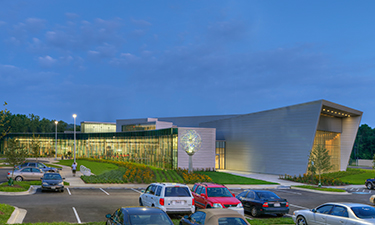 Research has shown that low-income minority communities often lack access to quality public facilities, including safe places to be physically active. However, critics can’t claim this to be the case in the historically African-American community of Fort Washington, Maryland, where Sorg Architects recently designed the Southern Regional Technology & Recreation Complex for the Maryland-National Capital Park and Planning Commission, setting a new benchmark for similar facilities throughout the region.
Research has shown that low-income minority communities often lack access to quality public facilities, including safe places to be physically active. However, critics can’t claim this to be the case in the historically African-American community of Fort Washington, Maryland, where Sorg Architects recently designed the Southern Regional Technology & Recreation Complex for the Maryland-National Capital Park and Planning Commission, setting a new benchmark for similar facilities throughout the region.
National Institutes of Health studies show that limited access to opportunities for physical activity is a risk factor for obesity, which is marginally more likely in low-income communities. Similarly, according to the National Council on Aging, “25 percent of older adults experience some form of anxiety, depression and dementia resulting from declining health, loss of independence and isolation,” a trend that is set to double by 2030. The mission of the new 40,000-square-foot, $15 million Tech Rec facility is to improve health and wellness — including social interaction and healthy living — for people of all ages in this community. “Your ZIP code should not determine your health status,” says epidemiology and obesity specialist Dr. Adam Drewnowski, “but it does.”
Building Design as a Solution
For Architect Suman Sorg, a primary goal in the planning and design of Tech Rec was to create an open and inviting space that encourages inclusiveness and fosters intergenerational interaction and connection. A focus on flexibility and multiple options for the use of each space shaped the planning for the complex, which includes a gymnasium, suspended indoor track, climbing wall, workout facilities, group exercise areas, large multipurpose room, professional recording studio, kitchen and classrooms. The building is considered an active and passive learning tool. Recreational spaces are wired to computer labs within the building to promote exercise and aid in educational instruction. The complex also features an expansive green roof with an open viewing gallery and lounge area.
The design of Tech Rec is the result of a process of restraint, leading to the strength and focus of a small number of bold moves. The most evident is the sweeping arc of glass that characterizes its main façade. This multi-colored expanse reflects the surrounding neighborhood and is a testament to the community’s significant participation and pride in bringing this project to fruition. To highlight this focal element and to respect the residential context, Sorg’s massing strategy shifts taller programmatic volumes, including the gymnasium, to the rear of the site, while the lower-scale concourse is situated facing the street.
In addition, the center was intentionally designed for sustainability, culminating in a LEED-Silver certification that recognizes its efficient planning and execution. The design includes a pond, several bioretention areas and a green roof on a large portion of the building. These features promote stormwater management quality control by reducing impervious cover, promoting infiltration, and capturing and treating the stormwater runoff from 100 percent of the average annual rainfall. The roof, which also includes roofing material with a high solar reflectance index, reduces heat gain and saves cooling costs. On the grounds, native and adaptive species were selected for the landscaping, so no permanent irrigation system was required.
Inside, a geothermal mechanical system with a ground source heat exchanger and high-efficiency water source heat pump provides climate control, and efficient materials and sensors contribute additional energy savings. Non-emergency lighting fixtures are automatically controlled to turn off during non-business hours, and low-flow plumbing fixtures are installed throughout the building. To support high air quality, staff enforce a no-smoking policy for 25 feet from all building entries and air intakes, and low-VOC (volatile organic compounds) materials were used wherever possible. Finally, to reduce the impact of new materials that needed to be created for the facility, 20 percent of the total construction materials were salvaged, refurbished or reused, and 10 percent were extracted, processed and manufactured within 500 miles of the project site.
Connecting Generations, Encouraging Healthy Living
The concourse’s design was borne from the desire to uncloak active functions, such as exercise areas and classrooms, which are ordinarily hidden from view in compartmentalized rooms. Here, the open layout of these areas serves to activate the space and facade. The creation of visual connections between the functional spaces within the concourse encourages users to try new program offerings, adds transparency and serves to increase security. This is accomplished through the primary organizing element of the concourse — a gently curving steel stair that leads to the mezzanine viewing area. The perforated metal panel that clads this structure meanders through the concourse as a screen and defines, along with clear and opaque glass panels, areas for instruction and spaces for gathering within the larger open area.
The community quickly and enthusiastically responded to the recreation center’s opening in August 2013, with 17,000 new members signing up within the first month.
Suman Sorg, AIA, is the President and Chief Designer for Sorg Architects.

